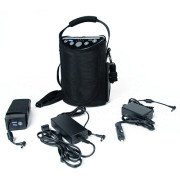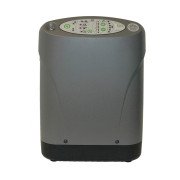- Stationary or Home Concentrators are quiet and easy to use. The oxygen output of these home oxygen machines ranges from 5 to 10 liters per minute (LPM)
- Portable Concentrators - are lightweight and great for travel. Many of our concentrators have been approved by the FAA for airline travel.
- Homefill Systems - are safe and easy to use. Patients can fill their own high pressure cylinders in the convenience of their own home. Get unlimited portable oxygen, cylinders may be filled over and over.
Oxygen Concentrators are used by Oxygen Therapy patients to treat emphysema and chronic obstructive pulmonary disease (COPD). The concentrated oxygen or O2 helps oxygen patients receive the level of oxygen their body needs. We carry a variety of oxygen concentrators, including home oxygen generators, non-portable oxygen concentrators, oxygen medical equipment, and oxygen therapy products. We carry only the best manufacturers of oxygen therapy products in the industry: Drive Medical, Respironics, Sequal and Invacare. These non-portable or home concentrators are quiet and easy to use. The oxygen output of these home oxygen machines ranges from 5 liters per minute (LPM) to 10 LPM.
Portable oxygen concentrators are lightweight and easily portable. They are powered by AC (Home), DC (Vehicle) or battery power, and the internal batteries automatically recharge when the unit is plugged in. The units weigh between eight and 20 pounds, and can be carried by a handle or with a shoulder strap on a carrying case. Many portable oxygen concentrators are also approved for air travel, so you can take them anywhere!
Home oxygen concentrators are a mobile oxygen therapy solution, take a look at our portable oxygen concentrators. We have a variety of oxygen concentrators, including home oxygen concentrators, home oxygen equipment, oxygen therapy products and oxygen supply parts including oxygen cylinders, pulse oximeters, oxygen masks, oxygen cannulas, oxygen regulators, oxygen concentrator filters, oxygen tubing, and other oxygen therapy accessories.
How oxygen concentrators work:
Oxygen concentrators operate on the principle of rapid pressure swing adsorption of atmospheric nitrogen onto zeolite minerals and then venting the nitrogen. This type of adsorption system is therefore functionally a nitrogen scrubber leaving the other atmospheric gasses to pass through. This leaves oxygen as the primary gas remaining. PSA technology is a reliable and economical technique for small to mid-scale oxygen generation, with cryogenic separation more suitable at higher volumes and external delivery generally more suitable for small volumes.
At high pressure, the porous zeolite adsorbs large quantities of nitrogen, due to its large surface area. After the oxygen and other free components are collected the pressure drops which allows nitrogen to desorb.
An oxygen concentrator has an air compressor, two cylinders filled with zeolite pellets, a pressure equalizing reservoir, and some valves and tubes. In the first half-cycle the first cylinder receives air from the compressor, which lasts about 3 seconds. During that time the pressure in the first cylinder rises from atmospheric to a few times normal atmospheric pressure (typically 20 psi/138 kPa gauge, or 2.36 atmospheres absolute) and the zeolite becomes saturated with nitrogen. As the first cylinder reaches near pure oxygen (there are small amounts of argon, CO2, water vapor, radon and other minor atmospheric components) in the first half-cycle, a valve opens and the oxygen enriched gas flows to the pressure equalizing reservoir, which connects to the patient's oxygen hose. At the end of the first half of the cycle, there is another valve position change so that the air from the compressor is directed to the 2nd cylinder. Pressure in the first cylinder drops as the enriched oxygen moves into the reservoir, allowing the nitrogen to be desorbed back into gas. Part way through the second half of the cycle there is another valve position change to vent the gas in the first cylinder back into the ambient atmosphere, keeping the concentration of oxygen in the pressure equalizing reservoir from falling below about 90%. The pressure in the hose delivering oxygen from the equalizing reservoir is kept steady by a pressure reducing valve.
Older units cycled with a period of about 20 seconds, and supplied up to 5 liters per minute of 90+% oxygen. Since about 1999, units capable of supplying up to 10 lpm have been available.










